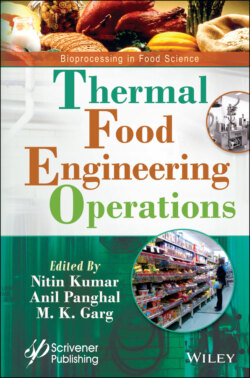Читать книгу Thermal Food Engineering Operations - NITIN KUMAR - Страница 18
1.3 Types of Thermal Technologies
ОглавлениеThermal processings are perhaps most essential in the food sector which has been used for the past many years; it has been discovered to increase the quality and shelf life of food with heat treatments. Thermal processing is the heating of foods at a particular temperature for a specified period of time. There are several techniques available in thermal technologies such as radiofrequency heating, ohmic heating, blanching, drying, frying, chilling, infrared heating, freezing and microwave heating, and extrusion. Combined high-pressure thermal treatment of food is also a very efficient prospect for the processing and preservation of food. The most common among them are microwave heating, ohmic heating, combined microwave vacuum-drying, radiofrequency processing, and new hybrid drying technologies.
Hybrid technologies are the recent development in engineering in the operation and design of the dryers to attain dried products with desired characteristics. In hybrid technologies, the drying technologies are combined with the new drying techniques to achieve a new age drying process to reduce energy consumption and enhance product quality. New age drying technologies would be very helpful for the bioproducts in agricultural sectors for all economic, environmental, and product quality aspects. Instant infusion is another new process for the heat treatment of food, depending upon the product requirement providing mild pasteurization and sterilization. For effective and efficient pasteurization and sterilization, the following are the needs: rapid and small heating time, accurate, and small residence time at sterilizing temperature, and rapid cooling time.
For examining the food when it goes under thermal process, nuclear magnetic resonance (NMR) and magnetic resonance imaging (MRI) can be used as they possess some unique properties for the same. Both of them can be used to investigate variation in the food during processing. Both of them are non-invasive and able to detect water mobility. NMR is the most versatile analytical technique used in modern times. It is capable of revealing complicated multivariate information inside the optically opaque and complex food matrix, also the thermal transformation in liquid, suspension, and gels regarding food samples. NMR and MRI are based on the magnetic properties of atomic nuclei and many elements have isotopes with such properties. Both of them are superior to any other instrumental methods because both are non-invasive, non-destructive, both measure volumes instead of surfaces, and are able to extract both physical and chemical information. By both techniques, it can extract knowledge about diffusion, flow, water distribution, and others. Furthermore, processes such as heating, freezing, hydration, dehydration, and salting can be detected and monitored non-invasively.
